Free Birth & Compatibility Charts
NEW Metaphysical Books at Amazon
Free Daily Personal Numerology Reading
Cell Salts for Your Sign
Your Life Path Number
|
Kuan Yin - The Compassionate RebelBy Nitin Kumar, EditorExotic India Art
It is unfortunate that Buddhism's most enduring (and
universal) contribution to the world has been insufficiently
translated as compassion. The original Sanskrit word
is 'karuna,' which holds within itself traces of the
fragment 'ru,' meaning to weep. While the Oxford dictionary
describes compassion as pity bordering on the merciful,
karuna is actually our ability to relate to another
in so intense a measure that the plight of the other
affects us as much as if it had been our own.
The term karuna is central to
the entire Buddhist tradition. It is frequently
described as a love for all beings, equal in intensity
to a mother's affection for her child. However,
it is quite unlike conventional love (Sanskrit:
priya, kama or trishna), which is rooted in dualistic
thinking and is egoistic, possessive and exclusive,
in contrast to the all-encompassing nature of compassion.
The root meaning of karuna is said to be the anguished
cry of deep sorrow and understanding that can only
come from an unblemished sense of oneness with others.
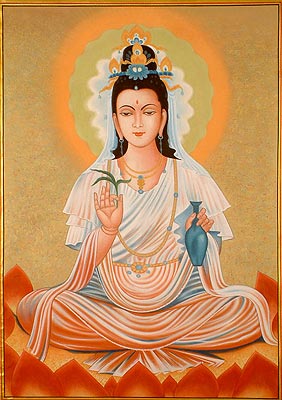
Kuan Yin
In fact, the evolution of Buddhism
in Asia and its spread throughout the world is,
from a spiritual point of view, none other than
the unfolding of karuna in history. Nowhere is this
more explicitly exemplified than in the Chinese
assimilation of Buddhism. Few would deny that the
defining symbol of this integration is the goddess,
who with her sweet and merciful disposition, has
won the hearts of not only the Chinese, but also
profoundly affected even those who, belonging to
a foreign tradition, have only had a fleeting interaction
with her. This divine female is none other than
Kuan Yin, beloved goddess of over a billion people
the world over. Her name too signifies her compassionate
nature, literally meaning 'One who hears the cries
of the world.'
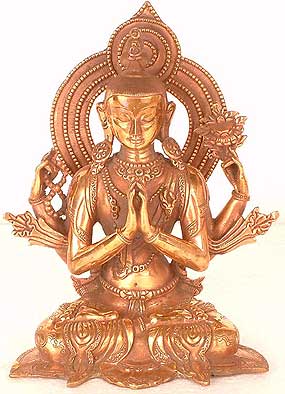
Four-Armed Avalokiteshvara
It remains a historical fact
that Kuan Yin is the Chinese version of the male
god Avalokiteshvara, whom the ancient texts eulogize
as the patron deity of compassion. It is fascinating
however to observe that nowhere in India (where
he originated) or Tibet (where he remains the most
popular deity) is the latter ever deified as a female
figure. In China too, his worship began as a male
god, but over time, changed into a goddess and by
the ninth century her popularity had prevailed over
that of Avalokiteshvara's.
There are many reasons why this
gender transformation took place. As Avalokiteshvara
evolved into the supreme personality of the Buddhist
pantheon, with this heightened pedestal came the
inevitable elitism. Karuna, however, cannot be and
is not (as it has become today under the pseudonym
of compassion), the exclusive preserve of a charmed
circle, but rather a symphonic identification with
the masses, sharing their suffering and pleasure
alike. No wonder then that Avalokiteshvara shed
streams of tears observing the plight of his people.
Now, any emanation from a divine form is bound to
hold a dynamic potential within itself and indeed
Indian mythology is replete with examples where
fluids emerging from deities have led to enormous
consequences. Tears similarly are a spontaneous
emotional response to external stimuli and represent
the outward flow of Avalokiteshvara's infinite karuna.
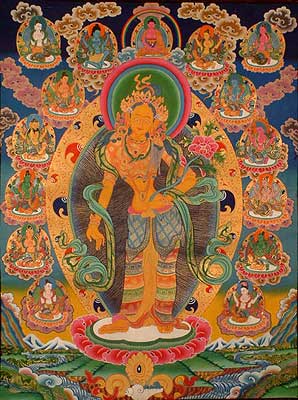
The Ever Graceful Tara
From these pearls emanated a
beautiful female as attractive as she was compassionate.
The goddess Tara, thus born, has continued her upward
spiral of popularity and remains one of the most
loved and widely recognized deities of the Buddhist
pantheon today. Truly, even though Avalokiteshvara
retains his foremost status in the gallery of Tibetan
gods, in the popular imagination it is Tara, who
with her supple charm, has come to symbolize the
tenderness of karuna.
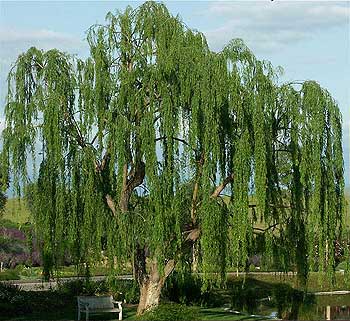
The Weeping Willow
It is relevant here to observe
that Kuan Yin is often depicted in art holding a
leafy twig, derived from the 'weeping willow' tree,
known so due to its trailing leafy branches that
droop to the ground and along which raindrops trickle
down like tears.
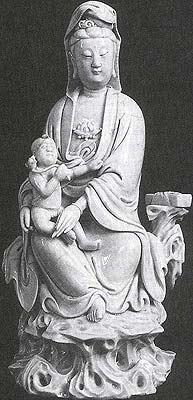
Kuan Yin as Child Giver
One of its distinctive characteristics
is remaining green throughout the year, pointing
perhaps to the goddess' fertility aspect, which
is further echoed in images showing her with an
infant.
The willow also has a deeper
and direct connection with Chinese culture and it
is believed that Lao Tzu, the author of Tao-te Ching,
loved to meditate under its shade (6th century BC).
It was under the same tree that the younger Confucius
had his famous interview with Lao Tzu, telling his
disciples afterwards:
"I know how birds fly, fishes
swim and animals run. But there is the dragon -
I cannot tell how he mounts on the winds through
the clouds, and rises to heaven. Today, having seen
Lao Tzu, I can only compare him to the dragon."
Over centuries, Kuan Yin's visual
depictions have highlighted her lithe, flowing form,
much like the willow tree itself, which has the
ability to bend during the most ferocious winds
and then spring back into shape again. Indeed, who
wants to stand rigid like the tall oak that cracks
and collapses in a storm? Instead, one needs to
be flexible like the willow, which survives the
tempest.
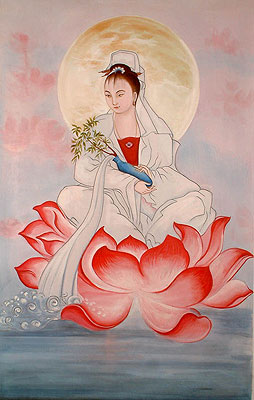
Kuan Yin
Or perhaps, Kuan Yin merely uses
the willow branch to sprinkle the divine nectar
of life on her devotees, which is stored in the
vase she holds in her other hand.
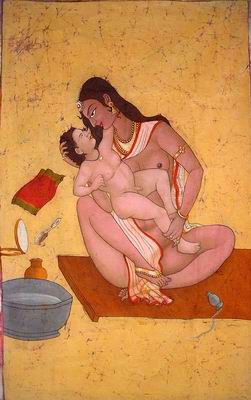
Mother and Child
The Chinese (ever disposed to
envisage friendly divinities in idealized human
forms), seem to have been initially perplexed by
Avalokiteshvara's complex iconography. Not for them
his thousand hands or even the seven eyes of Tara.
Exposed for eons to the essentially humanistic philosophy
of Confucianism, such images were alien and felt
to be unsuitable for portraying the 'soft' emotion
of karuna, the yearning passion a mother feels for
her child.
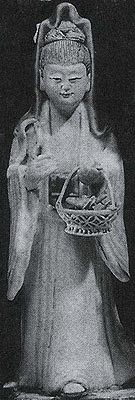
Kuan Yin Holding a
Fisherwomen's Basket
The Tibetan mind solved the craving
for a down to earth, visual embodiment of karuna
by envisioning the goddess Tara; the Chinese genius
did the same by enclosing this virtue in the graceful
and beautiful Kuan Yin, who was eminently human
in appearance and approachable by all. Indeed, she
gradually became the favored goddess of the peasants
and fishermen of China, retaining her place in their
hearts to the present day.
Additionally in China, not only
had popular gods always been real people who had
once lived in specific times and places, even mythical
figures were turned into historical cultural heroes
who were then venerated as the founding fathers
of Chinese civilization. Unlike Greece, where human
heroes were transformed into Olympian gods, in China
the reverse held true and if a god or goddess was
not perhaps originally a human being, there was
often an effort to turn her or him into one. Kuan
Yin thus again had to change from a goddess into
a living woman, so that she could be worshipped
as a Chinese goddess. Truly, the human character
of Chinese deities is one of the most distinctive
features of their religion, and like ordinary mortals
they too have birthdays, ancestries, careers and
titles. Therefore, even though Kuan Yin is not given
a date of birth in any of the Buddhist sutras, her
birthday is widely celebrated on the nineteenth
day of the second month of the lunar calendar.
The legend describing how Kuan
Yin was once a woman gives a fascinating insight
into the working of the Chinese genius and the process
by which she was given a distinctively local flavor
and absorbed into their pantheon:
It is said that in the past,
there once lived a king under whose rule the people
led a peaceful existence governed by Confucian ethics.
He had three daughters; the eldest two having already
married the grooms of their father's choice. The
youngest offspring however, was unlike any other
normal child. Firstly, when she was born, her body
glowed with an almost unearthly light so much so
that the palace seemed on fire. She was thus befittingly
named Miao Shan (Wonderful Goodness).
Secondly, as she grew up, she
wore only dirty clothes and never did display any
urge to adorn herself. Further, she would subsist
on only a single meal every day. In her conversations
she would talk about the impermanence of material
things and how human beings suffer because of their
attachment to such objects. Naturally worried about
their daughter's detached inclinations, her parents
proposed that (as per the Confucian ideals of filial
piety) she too marry a husband of their choice.
To this she replied:
"I would never, for the
sake of one lifetime of enjoyment, plunge into aeons
of misery. I have pondered on this matter and deeply
detest this earthly union (marriage)." Nevertheless,
when her parents insisted, she agreed to comply
with their wishes if only her future mate would
save her from the following three misfortunes:
1). When people are young, their
face is as fair as the jade-like moon, but when
they grow old, the hair turns white and faces become
wrinkled; whether walking, resting, sitting, or
lying down, they are in every way worse off than
when they were young.
2). Similarly, when our limbs
are strong and vigorous one may walk as if flying
through air, but when we suddenly becomes sick,
we are confined to the bed.
3). A person may have a large
group of relatives and be surrounded by his flesh
and blood, but when death comes, even such close
kin as father and son cannot take the person's place.
Finally she concluded: "If
indeed my future husband can ensure my deliverance
against these misfortunes, I will gladly marry him.
Otherwise, I vow to remain a spinster all my life.
People all over the world are mired in these kinds
of suffering. If one desires to be free of them,
the only option is to leave the secular world and
enter the gate of Buddhism." 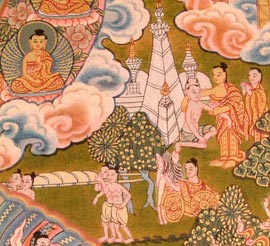
Buddha's Encounter
with Death
This narrative of course, is
parallel to one of the most significant episodes
from the life of the Buddha when he encountered
the three maladies of physical existence: sickness,
old age and death.
Exasperated to no end, the king
summoned an old and experienced nun of his kingdom.
He asked her to take the princess under tutelage
and expose her to as much hardship as possible in
the nunnery, so that she realize the futility of
her desired path. The instruction was tinged with
a threat of annihilation if after seven days Miao
Shan was not 'reformed'.
Needless to say, all the travails
she had to undergo at the monastery, including hard
manual labor, were insufficient to deter her from
the path of Dharma. However, Miao Shan did realize
that she was being thus subjected because the inhabitants
of the nunnery were under the threat of death. She
addressed them, saying:
"Don't you know the stories
about the ancient prince Mahasattva, who plunged
off the cliff in order to feed the hungry lions,
or King Sivi's cutting off his flesh to save a dove?
Since you have already left the life of a householder,
you should regard this material body as illusory
and impermanent. Why do you fear death and love
life? Don't you know that attachment to this dirty
and smelly leather bag (body) is an obstacle?"
At the end of the stipulated
period, the monarch, in a mad and frenzied reaction,
ordered that Miao Shan be beheaded. As her executioners
approached the monastery gates, Miao Shan rushed
out of the building, eager to embrace her impending
death. No sooner had she kneeled at the stake and
the deadly sword been raised, than a blinding thunder
rose. Before the assailants could regain their composure,
a tiger darted out of the darkness and carried away
the swooning girl into the nearby hills. The king,
now beyond the bounds of reason, ordered the hermitage
to be burnt down with all its inhabitants.
It was not long before his karma
caught up with him and he fell sick with kaamla
(jaundice). He was restless for days on end, finding
no rest even in sleep. The disease spread all over
his body and the best doctors throughout the land
were unable to cure him. One day, a holy mendicant
came to his door and predicted: "If some person
would willingly consent to give his or her arms
or eyes without the slightest anger or resentment,
the elixir made of these potent ingredients will
surely relieve you from your suffering."
"Where alas will I find
such a compassionate being?" lamented the king.
"In this very land," said the monk. "Go
southwest in your dominion, on top of the mountain
there is a hermit who possesses all the characteristics
which are necessary for your healing."
No sooner had he heard this than
the king ordered his envoys to hurry to the abode
of the recluse. On being informed of his plight
and its prescribed remedy, the hermit readily agreed
to undergo the supreme sacrifice, requesting them
to ask the suffering king to direct his mind to
the three treasures of Buddhism and then very calmly
proceeded to gauge out both the eyes and asked one
of the men to sever the two arms. The three worlds
shook under the impact of this terrible sacrifice.
When he had fully recovered,
the king made haste with his wife to pay homage
to the one who had so miraculously saved his life.
After bowing low before the mutilated form, as soon
as they raised their heads they let out a shriek
of astonished horror; the hermit's true identity
lay bare before them. She was none other than their
youngest daughter Miao Shan. Realizing what she
had done for him, despite all that he had done to
her, the king fell prostrate upon the floor and
asked for forgiveness. Overcome with emotion, the
parents embraced her and the father said: "I
am so evil that I have caused my own daughter terrible
suffering." Miao Shan replied,
"Father, I have suffered
no pain. Having given up these human eyes, I shall
see with diamond eyes. Having yielded the mortal
arms, I shall receive golden arms. If my calling
is true all this will follow."
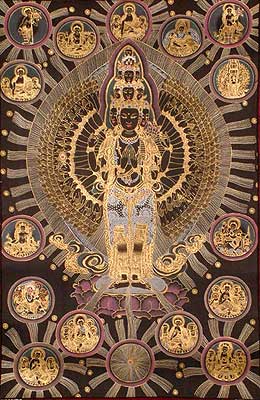
Eleven Headed Thousand
Armed Avalokiteshvara
Much sobered by this intense
experience, the king returned to his palace and
ordered a statue to be made of her, which, emphasizing
her sacrifice was to be without eyes and hands.
Now, in Chinese, the sound for 'bereft' or 'deficient'
are virtually identical with 'thousand.' At some
stage in the transmission of this message, the two
words were confused and the sculptor toiled away,
desperately seeking some way to capture the essence
of the king's wishes. He very imaginatively (or
perhaps following Indian or Tibetan models) placed
one eye on each palm, making the number of eyes
equal to the arms,
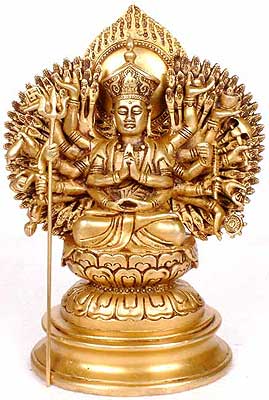
Thousand-Armed Kuan
Yin
Giving rise in the process to
an awesome and complex image of breathtaking splendor.
Unable to relate to the thousand-armed
Avalokiteshvara, the above legend provided a rational
explanation to the bewildered viewer and helped
integrate the goddess into the Chinese ethos.
The story of Miao Shan represents
the fusion of the Buddhist theme of the gift of
the body and the Confucian concept of filial piety.
In the former tradition, giving is one of the six
perfections performed by a bodhisattva (would be
Buddha). Amongst the different forms of gifts, that
of one's own body is the best. The only difference
is that while the bodhisattvas give up their bodies
in order to feed or save sentient beings regardless
of any formal relationship with them, the fact that
Miao Shan does so for her father is where the Confucian
model comes in. In the former context, a tale is
narrated of the Buddha, who in one of his previous
births was a pigeon. He saw a man lose his way during
a snowstorm, driven to the point of starvation.
The pigeon gathered twigs and leaves, made a fire
and threw himself wholeheartedly into it, to become
food for the distressed soul. It is this lofty ideal
that Kuan Yin was following, a self-sacrifice par
excellence, motivated by pure (selfless) and indiscriminate
compassion (karuna).
On the other hand, Kuan Yin as
Miao Shan gives a bold and provocative message,
challenging Confucian value systems as delineated
in the 'Classic of Filial Piety' (published by the
emperor Xuan in AD 722). Her life glorifies austerity,
celibacy and renunciation, which, as per Buddhism,
are highly valued (against the householder, who
is necessary in Confucianism for creating offspring
to perpetuate the lineage). In times of the Ming
for example, one could achieve religious sanctification
by performing one's domestic obligations to the
fullest degree. Eventually, Chinese of all social
strata and both sexes came to know Kuan Yin as the
strong-willed yet filial girl, who refused to get
married and rebelled against stifling authority.
Conclusion:
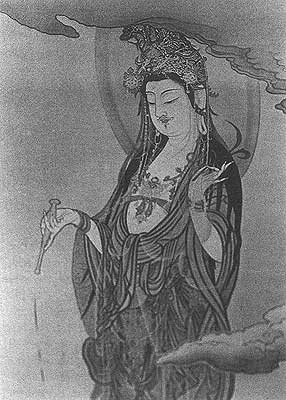
Kuan Yin with Moustache
The goddess Kuan Yin is a symbol,
not only of the Chinese assimilation of Buddhism,
but also of the many hued flavor of karuna, expressed
through the softer wisdom of a woman. She is a pointer
to the re-emergence of the goddess and the gender
transformation of Avalokiteshvara in China represents
perhaps a universal imperative, which is similarly
reflected in the emanation of the goddess Tara from
the compassionate tears of the same bodhisattva.
Though often images are encountered, which show
her sporting a moustache, emphasizing masculinity;
this is negated by the softness of her demeanor.
Can anything be more subtly female
than her graceful poise - modest and inward looking,
yet potent enough to generate and compassionately
nourish the whole outside world? In the words of
Martin Palmer: "The divine feminine cannot
be suppressed for long. In China, it emerged by
the transformation of the male into the female,"
only god (or the goddess) knows how it will transpire
in other cultures.
References and Further Reading
- Blofeld, John. Bodhisattva
of Compassion The Mystical Tradition of Kuan Yin:
Boston, 1988.
- Boucher, Sandy. Discovering
Kwan Yin, Buddhist Goddess of Compassion: Boston,
1999.
- Cabezon, Jose Ignacio. Buddhism,
Sexuality, and Gender: Delhi, 1992.
- Colin, Didier. Dictionary
of Symbols, Myths and Legends: London, 2000.
- Farrer-Halls, Gill. The Feminine
Face of Buddhism: Illinois, 2002.
- Jones, Lindsay (ed). Encyclopedia
of Religion (Previously Edited by Mircea Eliade)
15 volumes: MI, 2005.
- Keown, Damien. Oxford Dictionary
of Buddhism: Oxford, 2003.
- Kinsley, David. The Goddesses'
Mirror Visions of the Divine from East and West:
Delhi, 1980.
- Palmer, Martin and Jay Ramsay,
with Man-Ho Kwok. Kuan Yin Myths and Prophecies
of the Chinese Goddess of Compassion: London,
1980.
- Phillips, Kathy J. (Photography
by Joseph Singer). This Isn't a Picture I'm Holding:
Kuan Yin: Honolulu, 2004.
- Watson, Burton (translator).
The Lotus Sutra: Delhi, 1999.
- Wright, Arthur F. Buddhism
in Chinese History: Stanford, 1959.
- Yu, Chun-Fang. Kuan Yin The
Chinese Transformation of Avalokiteshvara: Columbia,
2001.
Visit ExoticIndiaArt.com
 
|
|